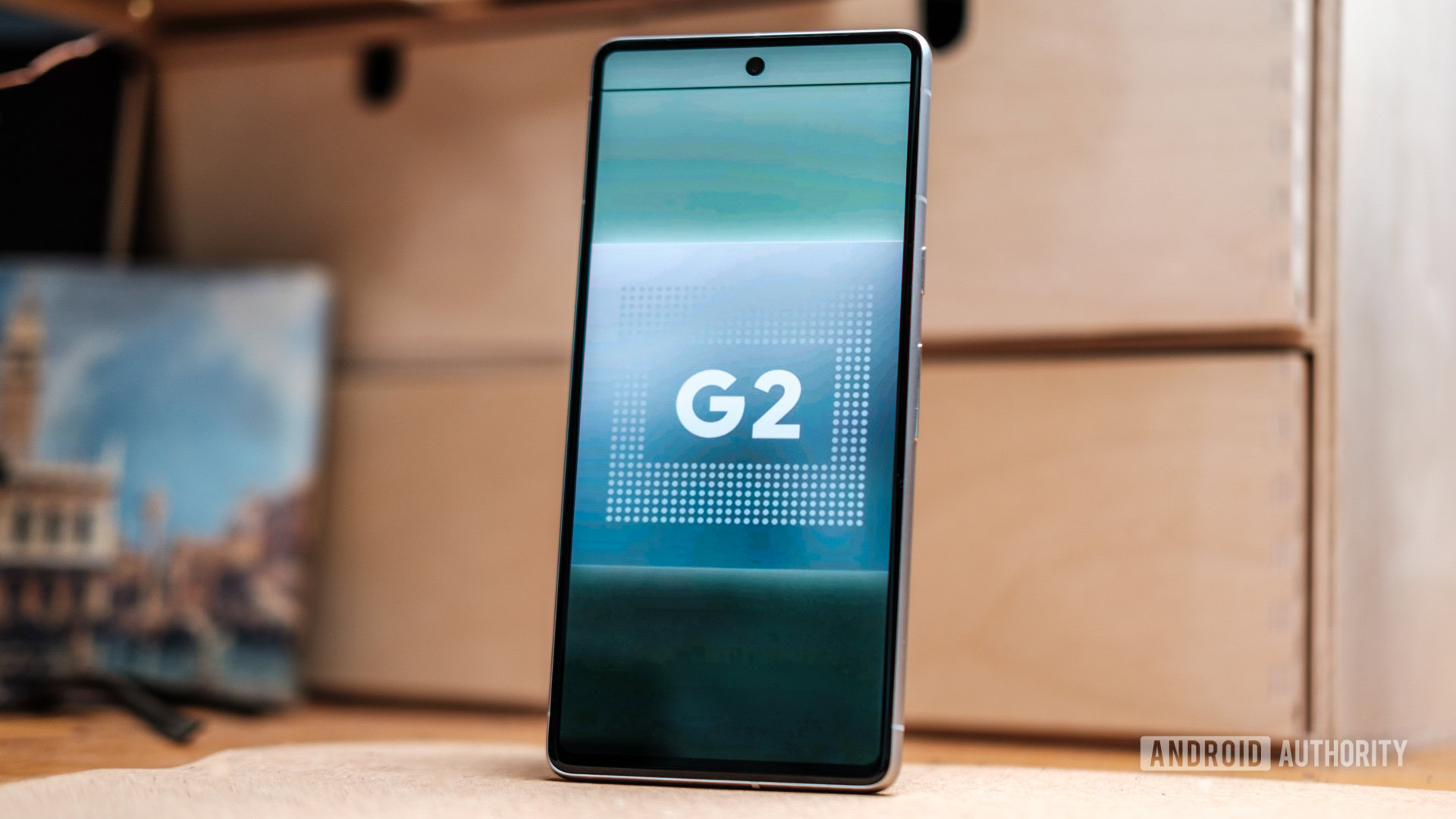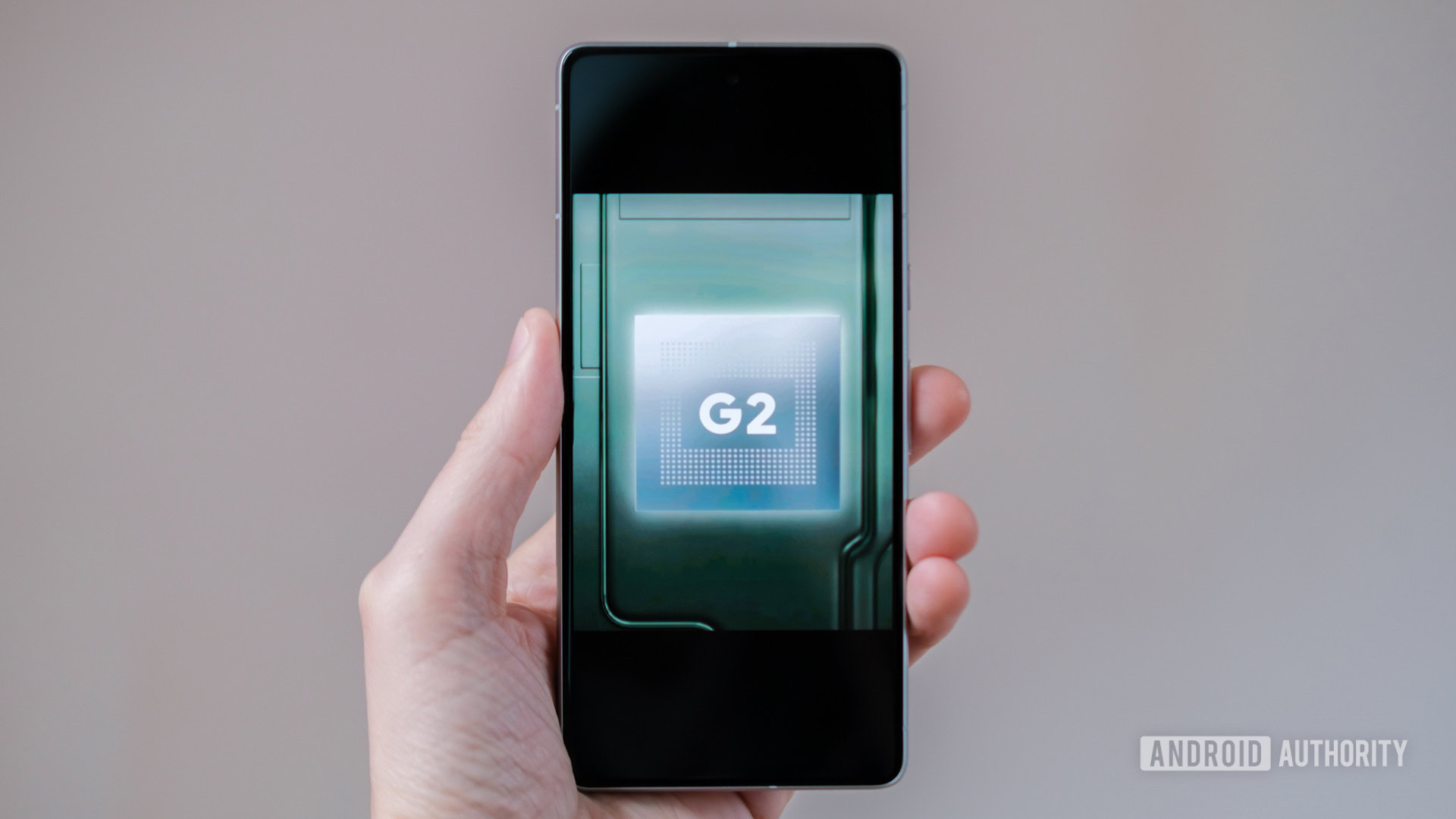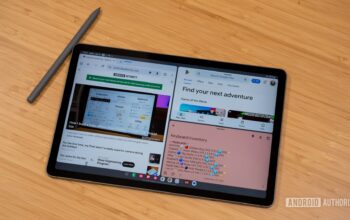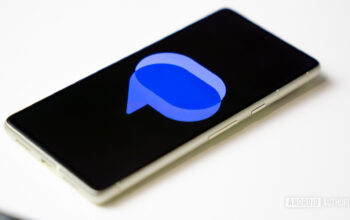
Robert Triggs / Android Authority
The Pixel 6 series was a landmark release for Google in many ways, introducing ultra-competitive pricing, upgraded cameras, and a semi-custom Tensor system on a chip (SoC) for the first time. Google’s brand-new Pixel 7 series picks up where the Pixel 6 left off, offering the same pricing and similar cameras, but a new Tensor G2 chipset. We’ve already covered the Tensor G2 in our deep dive, taking a look at specs and features. But now that we have the Pixel 7 series phones in our hands and can share our test findings, let’s take a look at how it fares in benchmarks against the first generation Tensor chip and the best rival silicon.
How does Google’s new chip stack up on paper?
| Google Tensor G2 | Google Tensor | |
|---|---|---|
|
CPU |
Google Tensor G2
2x Arm Cortex-X1 (2.85GHz) |
Google Tensor
2x Arm Cortex-X1 (2.80GHz) |
|
GPU |
Google Tensor G2
Arm Mali-G710 MP7 |
Google Tensor
Arm Mali-G78 MP20 |
|
Caches |
Google Tensor G2
4MB CPU L3 |
Google Tensor
4MB CPU L3 |
|
RAM |
Google Tensor G2
LPDDR5 |
Google Tensor
LPDDR5 |
|
Machine Learning |
Google Tensor G2
Next-gen Tensor Processing Unit |
Google Tensor
Tensor Processing Unit |
|
Media Decode |
Google Tensor G2
H.264, H.265, VP9, AV1 |
Google Tensor
H.264, H.265, VP9, AV1 |
|
Modem |
Google Tensor G2
4G LTE |
Google Tensor
4G LTE |
|
Process |
Google Tensor G2
Samsung 5nm |
Google Tensor
Samsung 5nm |
At first glance, it looks like the Tensor G2 isn’t a huge upgrade over the original Tensor processor. The CPU still looks similar to the Pixel 6 chipset, with two Cortex-X1 heavy cores and four little Cortex-A55 cores. Google does provide a tiny 50MHz clock speed boost for the X1 cores. However, the two medium Cortex-A76 cores seen in the original SoC have been replaced by two Cortex-A78 cores. By comparison, the Snapdragon 8 Gen 1 family, Samsung Exynos 2200, and Mediatek Dimensity 9000 series all offer much newer CPU components. It stands to reason that the Tensor G2 won’t surpass those SoCs when it comes to CPU benchmarks. But what about the GPU?
| Google Tensor G2 | Apple A16 Bionic | Snapdragon 8+ Gen 1 | Exynos 2200 | |
|---|---|---|---|---|
|
CPU |
Google Tensor G2
2x Arm Cortex-X1 (2.85GHz) |
Apple A16 Bionic
2x Everest (3.46GHz) |
Snapdragon 8+ Gen 1
1x Cortex-X2 (3.2GHz) |
Exynos 2200
1x Cortex-X2 (2.8GHz) |
|
GPU |
Google Tensor G2
Arm Mali-G710 MP7 |
Apple A16 Bionic
Apple 5-core GPU |
Snapdragon 8+ Gen 1
Adreno 730 |
Exynos 2200
Xclipse 920 |
|
Caches |
Google Tensor G2
4MB shared L3 |
Apple A16 Bionic
24MB system cache |
Snapdragon 8+ Gen 1
6MB shared L3 |
Exynos 2200
Unknown |
|
RAM |
Google Tensor G2
LPDDR5 |
Apple A16 Bionic
LPDDR5 |
Snapdragon 8+ Gen 1
LPDDR5 |
Exynos 2200
LPDDR5 |
|
Machine Learning |
Google Tensor G2
Next-gen Tensor Processing Unit |
Apple A16 Bionic
16-core Neural Engine |
Snapdragon 8+ Gen 1
Hexagon |
Exynos 2200
Dual-core NPU |
|
Media Decode |
Google Tensor G2
H.264, H.265, VP9, AV1 |
Apple A16 Bionic
H.264, H.265, VP9 |
Snapdragon 8+ Gen 1
H.264, H.265, VP9 |
Exynos 2200
H.264, H.265, VP9, AV1 |
|
Modem |
Google Tensor G2
4G LTE |
Apple A16 Bionic
4G LTE |
Snapdragon 8+ Gen 1
4G LTE |
Exynos 2200
4G LTE |
|
Process |
Google Tensor G2
Samsung 5nm (5LPE?) |
Apple A16 Bionic
TSMC N4 |
Snapdragon 8+ Gen 1
TSMC N4 |
Exynos 2200
Samsung 4LPE |
Well, Google is offering upgraded graphics hardware here in the form of the Arm Mali-G710 MC7. This is fundamentally the same GPU as the Dimensity 9000 series, albeit with three fewer shader cores. So we’re expecting performance to come in just below the Mediatek chipset. The ace up the Tensor G2’s sleeve is its upgraded Tensor Processing Unit (TPU) for machine learning. Google says it’s capable of running speech and camera tasks up to 60% faster than the original chipset. Nevertheless, our benchmarks focus mainly on CPU and GPU tasks.
Google Tensor G2 CPU and GPU benchmarks
We start with the classic Geekbench 5 benchmark, which tests a phone’s CPU performance. The results show that the Tensor G2’s single-core performance is almost identical to the original Tensor chipset. This isn’t a surprise given the essentially identical Cortex-X1 cores, with only a 50MHz clock speed boost over the first-generation Tensor. However, the single-core score lags behind both the Snapdragon and Exynos models of Samsung’s Galaxy S22 Ultra, as well as the Asus ROG Phone 6 and 6D (Snapdragon 8 Plus Gen 1 and Dimensity 9000 Plus, respectively) and Apple’s iPhone 14 series (A16 Bionic). The Tensor G2 fares better when it comes to multi-core CPU performance. The Pixel 7 series delivers a score that’s as much as 16% higher than the Pixel 6 line, and it’s within touching distance of Snapdragon 8 Gen 1 phones. Needless to say, Google’s decision to swap out those old Cortex-A76 CPU cores for Cortex-A78 cores has paid dividends here.
The Tensor G2 enjoys a 16% multi-core CPU boost, but single-core performance is identical to the original Tensor.
Moving to the GPU benchmarks, it’s clear that the Tensor G2 isn’t a step forward from the first-generation Tensor processor. Last year’s chipset delivered 3DMark Wild Life scores that were up to ~3% better than the new processor.
The original Tensor employed a Mali-G78 GPU with a 20-core design, while the Tensor G2 brings a Mali-G710 GPU with seven shader cores. Our own testing and analysis elsewhere showed that one Mali-G710 shader core delivers roughly 2x to 3x the performance of one Mali-G78 core, which is what we’re seeing here. We can only surmise that the company didn’t chase higher GPU performance for lower peak temperatures and to possibly free up silicon area for components like the CPU and TPU.
The Tensor G2 doesn’t make any advances when it comes to peak graphical performance.
Needless to say, the Tensor G2 GPU doesn’t fare well against rival SoCs seen in 2022 flagship phones. The Snapdragon 8 Plus Gen 1 in particular brings 3DMark Wild Life scores that are up to ~59% higher than the Pixel 7 series. It’s also interesting to see the Dimensity 9000 Plus produce GPU scores that are ~36% higher than the Pixel 7’s chipset. We don’t know the clock speeds, but with 10 shader cores to the Tensor G2’s seven, Mali-G710 performance doesn’t seem to quite scale linearly with core count. Things don’t look much better when taking a peek at the PCMark benchmark. This test puts the entire system through its paces to give a better overall picture of what the phone can do for a range of typical workloads. At best, the Tensor G2 is on virtually the same playing field as the original Tensor. At worst, however, it’s 7.7% down on the Pixel 6 processor. Either way, it’s at the bottom of the list here.
Stress testing for sustained performance
One-off benchmarks are only part of the story though, as sustained performance is just as important for smartphone processors. After all, what’s the point of a phone delivering fantastic peak performance in a game for only two minutes? So we ran the 3DMark Wild Life Stress Test, which performs 20 consecutive GPU tests in order to give us a better idea of sustained performance versus the original Tensor. There’s some good news here for the Tensor G2, the handset offers far better sustained performance than its predecessor. While the initial run scores are close between all four handsets, the Pixel 6 and 6 Pro collapse almost immediately and continue to worsen until near the end of the test. The Pixel 7 and 7 Pro scores also decline, but it takes longer and happens at a slower rate.
A GPU stress test shows that the Pixel 7 series does a much better job of sustained performance than the Pixel 6.
Looking at the percentages, the Pixel 6’s performance fell by ~55% from the first run to the last run, while the Pixel 6 Pro’s scores dropped by ~51%. By comparison, the Pixel 7 and Pixel 7 Pro’s scores declined by a far more respectable ~25% and ~19% respectively. Still not great, but substantially improved. It’s worth noting that these stress tests aren’t necessarily representative of real-world scenarios, which are typically less demanding. But it does suggest that your new Pixel phone should be able to deliver a much smoother gaming experience over time than last year’s model. Particularly when more demanding titles hit the market.
How does the Pixel 7 series compare to Qualcomm’s Snapdragon flagship chipsets, though? We’ve stress-tested several Snapdragon 8 Gen 1 and Snapdragon 8 Plus Gen 1 phones against the Tensor G2 devices. These phones clearly start off with far more impressive scores than the Pixel 7s, and the ROG Phone 6 maintains a healthy lead throughout the test regardless of performance mode. This is likely due to the gaming handset’s emphasis on cooling combined with a more efficient TSMC 4nm Snapdragon 8 Plus Gen 1.
Snapdragon-powered smartphones start off strong in the stress test, but the ending is another story.
That said, the Asus Zenfone 9 with its Snapdragon 8 Plus Gen 1 SoC sees a dip that falls below the Tensor G2 phones. Likely due to its compact form factor and therefore worse heat dissipation. Other earlier Snapdragon 8 Gen 1 handsets throttle back much quicker than the Tensor G2 as well. Although they still provide higher performance for several minutes, many score in the same ballpark at the end of the test.
The Tensor G2 sustains performance better than some Snapdragon 8 Gen 1-powered phones.
For what it’s worth, the ROG Phone 6’s scores dropped by 40% from the first run to the last run (and by just 9.5% in its performance mode). Meanwhile, the Zenfone 9’s performance dropped by ~47% compared to its first run. On the other hand, the Galaxy S22 Ultra dropped by a massive ~52%, and the Sony Xperia 1 IV saw a performance decline of 51%. Those are all much worse metrics than the Tensor G2. While the Snapdragon-toting phones start off way stronger than Google’s new phones, the Tensor G2 generally doesn’t see the same drastic performance drops under sustained pressure. And this sustained performance means it can compete with and even outperform some Snapdragon 8 Gen 1 phones over an extensive stress test.
Google Tensor G2 performance: The verdict

Robert Triggs / Android Authority
Taken together, the benchmarks show that the Tensor G2 is not quite at a standstill, but it’s not a big leap forward for Google either — at least when it comes to CPU and GPU testing. The switch to a more recent but still last-generation Cortex-A78 CPU for the medium cores pays off when it comes to multi-core performance. These scores show a large improvement over the original Tensor and put the G2 within punching distance of 2022’s top Android processors. But the decision to stay with two Cortex-X1 CPU cores also means that single-core performance remains almost identical to the first-gen Tensor. Meanwhile, Qualcomm and Apple are extending their lead with newer, more powerful CPU tech.
Do you think Google nailed the Tensor G2?
1141 votes
GPU results reveal a double-edged sword in our Tensor G2 benchmarks. Classic one-off benchmarks show it’s actually a little slower than its predecessor and a lot slower than rival chips. However, stress testing is a different story altogether as the Pixel 7 series manages to deliver much better sustained performance than the first-gen Tensor. The stress test also shows that while the 2022 Snapdragon flagship silicon offers better peak performance, the Tensor G2 is able to deliver more stable results and can actually beat some Snapdragon 8 Gen 1 handsets. There’s a strong argument to be made that sustained performance is more important than peak performance when it comes to gaming on smartphones.
Either way, the Tensor G2 is still some way off 2022’s top Android phone processors in most benchmarks. And the gap between Google and rivals will only widen with 2023’s flagship silicon just a couple of months away. That said, Google’s more conservative approach delivers a smooth experience without the same level of throttling that plagued the original Tensor. Throw in Google’s machine learning improvements to power unique software experiences, and Tensor G2 doesn’t look like a bad upgrade at all.



